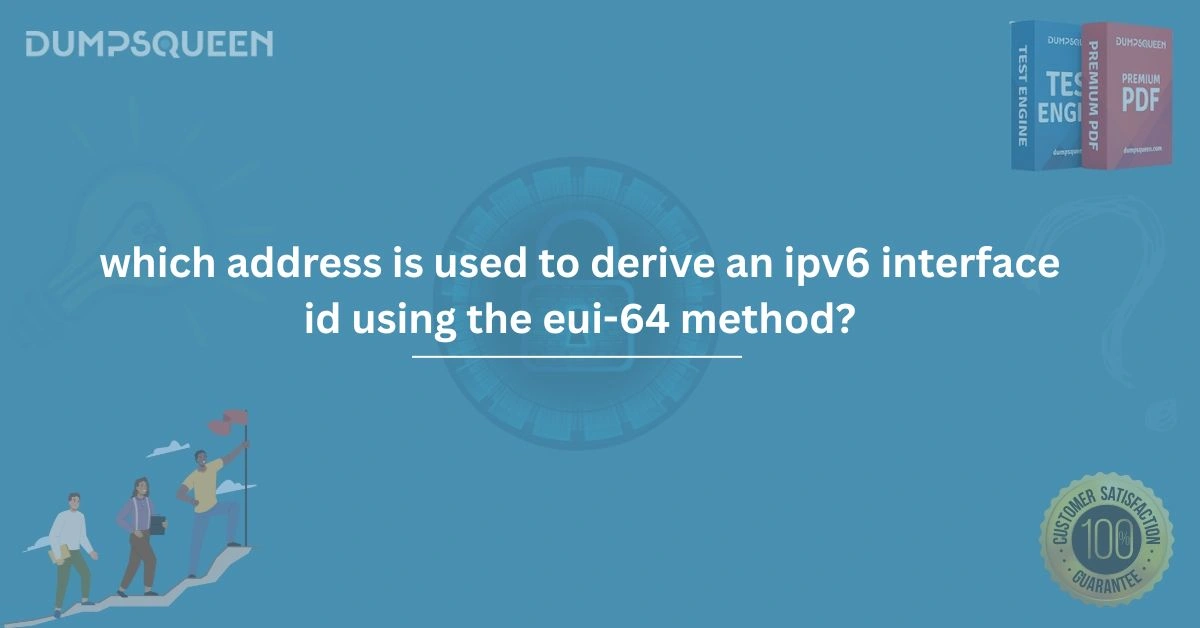Introduction
The world of networking has evolved significantly in the last few decades, moving from limited IPv4 addressing to the expansive capabilities of IPv6. With this evolution, there has been a rise in the need to understand how IPv6 addresses are configured and utilized. One of the most common topics that surfaces in IPv6 discussions is the EUI-64 method of interface ID generation. Particularly for those preparing for networking certifications such as Cisco’s CCNA or CompTIA Network+, understanding the mechanism behind EUI-64 is crucial. At DumpsQueen, we specialize in providing accurate, exam-ready resources that not only help candidates understand these foundational networking principles but also prepare them to face certification exams with confidence. This blog offers an in-depth look into the question: Which address is used to derive an IPv6 interface ID using the EUI-64 method? We’ll walk through the logic behind the EUI-64 format, explain its technical workings, and demonstrate how the interface ID is derived using the MAC address of a device.
The Basics of IPv6 Addressing
IPv6, or Internet Protocol version 6, was introduced to overcome the limitations of IPv4. The most notable improvement is the address size, moving from 32-bit to 128-bit addresses. An IPv6 address is divided into two main parts: the network prefix and the interface identifier. While the network portion is generally assigned by the network provider or administrator, the interface ID can be auto-generated using several methods one of which is the EUI-64 method. The EUI-64 format, which stands for Extended Unique Identifier, allows a device to create a unique 64-bit interface ID from its 48-bit MAC (Media Access Control) address. This ensures that each device on a network has a unique IPv6 address without manual configuration.
What is EUI-64 and Why Is It Used?
The EUI-64 method is a standard mechanism defined by the IEEE (Institute of Electrical and Electronics Engineers) for generating interface IDs in IPv6 networks. This method is particularly useful in environments where devices are frequently added or removed, as it ensures uniqueness without requiring manual address management. In simple terms, the MAC address of a device is used to derive the interface ID using the EUI-64 format. Since a MAC address is only 48 bits long and the IPv6 interface ID needs to be 64 bits, EUI-64 inserts a predefined pattern in the middle of the MAC address and flips a specific bit to signify uniqueness at the global or local level. So, to answer the question directly the MAC address is the base used to derive an IPv6 interface ID using the EUI-64 method.
Step-by-Step: Deriving an IPv6 Interface ID Using EUI-64
Let’s walk through how the EUI-64 process works, assuming we have a device with a MAC address of 00:1A:2B:3C:4D:5E.
-
Split the MAC Address into Two Halves:
The MAC address is divided into two 24-bit halves:-
First half:
00:1A:2B -
Second half:
3C:4D:5E
-
-
Insert the EUI-64 Insertion Pattern:
Insert the fixed valueFF:FEin the middle:-
Result:
00:1A:2B:FF:FE:3C:4D:5E
-
-
Invert the Universal/Local Bit:
The seventh bit in the first byte of the MAC address is the Universal/Local (U/L) bit.-
Original first byte:
00(in binary:00000000) -
Flip the 7th bit: becomes
00000010(which is02in hex) -
Final result:
02:1A:2B:FF:FE:3C:4D:5E
-
-
Combine With the IPv6 Network Prefix:
If the network prefix is2001:0DB8:AC10:FE01::/64, then the full IPv6 address is:-
2001:0DB8:AC10:FE01:021A:2BFF:FE3C:4D5E
-
This is how the interface ID is automatically derived using the EUI-64 format from the original MAC address.
Benefits of Using EUI-64
The use of EUI-64 offers several key advantages in both enterprise and home networking environments. Firstly, it minimizes human error by reducing the need to manually assign interface IDs. Secondly, it promotes uniqueness, which is crucial in global-scale networks. Devices configured using EUI-64 are less likely to face address duplication issues. For professionals working toward certifications, knowing this process not only helps with exam readiness but also strengthens practical networking skills. At DumpsQueen, our exam resources break down such complex processes into easily digestible formats so candidates can quickly grasp both theory and application.
Concerns Around EUI-64
While EUI-64 is useful, it has come under scrutiny in terms of privacy. Since MAC addresses are globally unique and tied to a physical device, deriving the interface ID from the MAC address makes the device traceable across networks. This can be a privacy concern, particularly in sensitive environments. To mitigate this, newer operating systems often use Privacy Extensions for Stateless Address Autoconfiguration (SLAAC), which generates randomized interface IDs that change over time. However, EUI-64 is still widely used in many enterprise-grade routers and networking devices.
Real-World Example
Let’s consider a network where a router advertises the IPv6 prefix 2001:db8:abcd:12::/64. A device with MAC address F4:5C:89:93:46:AB joins the network.
Following the EUI-64 process:
-
Split MAC into:
F4:5C:89and93:46:AB -
Insert
FF:FE:F4:5C:89:FF:FE:93:46:AB -
Flip the 7th bit of
F4(which is binary11110100), flipping the 7th bit gives11110110, which isF6 -
Final interface ID:
F65C:89FF:FE93:46AB -
Full IPv6 address:
2001:db8:abcd:12:F65C:89FF:FE93:46AB
This demonstrates how automated IPv6 configuration simplifies device integration within networks.
Importance in Certification Exams
Understanding this concept is vital for networking certifications. Whether you're preparing for Cisco’s CCNA, CompTIA Network+, or similar credentials, questions around EUI-64 and IPv6 interface ID generation are quite common. DumpsQueen offers thoroughly prepared dumps, guides, and practice questions tailored for these topics. We ensure that every student understands not only how to pass but also how to apply their knowledge in real-world settings.
Free Sample Questions
Question 1: Which address is used to derive an IPv6 interface ID using the EUI-64 method?
A) IPv4 address
B) Hostname
C) MAC address
D) DNS address
Correct Answer: C) MAC address
Question 2: What is inserted into a MAC address when using the EUI-64 method to form the interface ID?
A) FE:FE
B) FF:FE
C) 00:00
D) AA:AA
Correct Answer: B) FF:FE
Question 3: Which bit is flipped in the MAC address when using EUI-64 for IPv6 interface ID generation?
A) 3rd bit
B) 4th bit
C) 7th bit
D) 8th bit
Correct Answer: C) 7th bit
Question 4: Why do some systems avoid using EUI-64 for IPv6 interface ID generation?
A) It reduces performance
B) It causes collisions
C) It raises privacy concerns
D) It’s not compatible with modern networks
Correct Answer: C) It raises privacy concerns
These MCQs are just a glimpse of the level of quality and relevance you can expect from DumpsQueen’s full suite of certification exam preparation materials.
Tools That Automate EUI-64 Generation
Many routers and operating systems now include built-in tools that automatically calculate EUI-64 interface IDs. Cisco IOS devices, for example, use the ipv6 address autoconfig command, which uses the router-advertised prefix and combines it with the EUI-64 derived interface ID. Similarly, operating systems like Linux, Windows, and macOS have native support for this configuration method, allowing plug-and-play connectivity for IPv6-enabled networks. For exam takers, understanding these tools' functionality is essential. Knowing what happens under the hood makes configuration troubleshooting much easier and helps in diagnosing connectivity issues more efficiently.
DumpsQueen and Your Exam Success
At DumpsQueen, we go beyond simple memorization. Our learning materials are designed to build a deep conceptual understanding of networking topics, just like the EUI-64 method. Our practice questions, explanations, and real-world labs help reinforce your knowledge and prepare you for success in any professional certification exam. Whether you’re aiming for Cisco’s 200-301 (CCNA), CompTIA Network+, or other networking credentials, our materials align with the latest syllabus and exam objectives. We understand what examiners are looking for and we make sure you're ready to deliver.
Conclusion
In summary, the EUI-64 method is an intelligent and standardized way to automatically generate a unique IPv6 interface ID based on a device’s MAC address. It brings scalability, simplicity, and uniqueness to network addressing. However, understanding its internal workings such as flipping the U/L bit and inserting FF:FE is crucial not only for practical networking tasks but also for clearing certification exams. To directly answer the blog’s central question the address used to derive an IPv6 interface ID using the EUI-64 method is the device’s MAC address. This method ensures a globally unique identifier within the IPv6 structure, supporting efficient communication and automated device configuration. For learners, professionals, and certification aspirants, this topic remains one of the most tested and relevant in the domain of networking. With DumpsQueen by your side, you gain access to expert-backed resources that elevate your preparation and take you a step closer to certification success.




